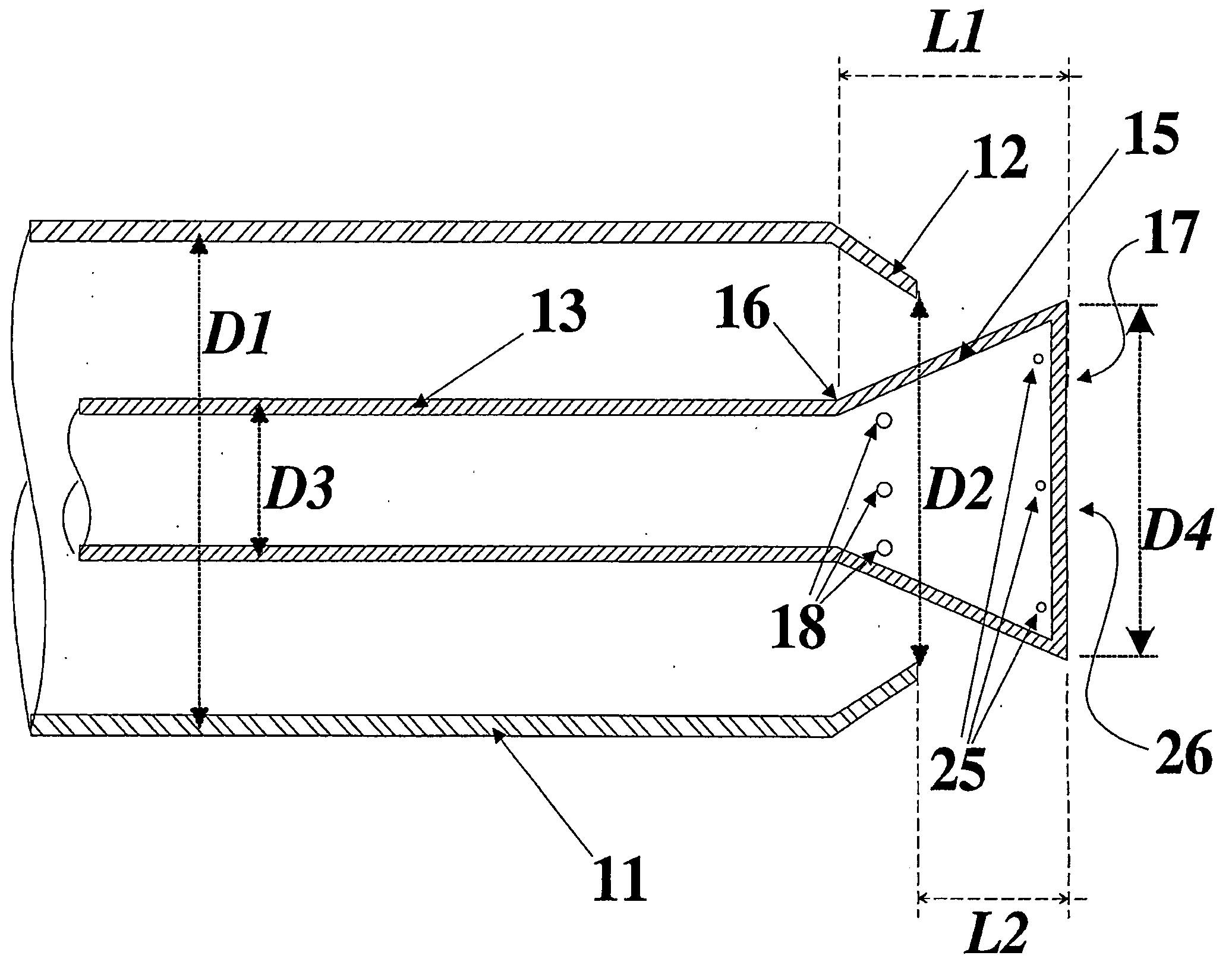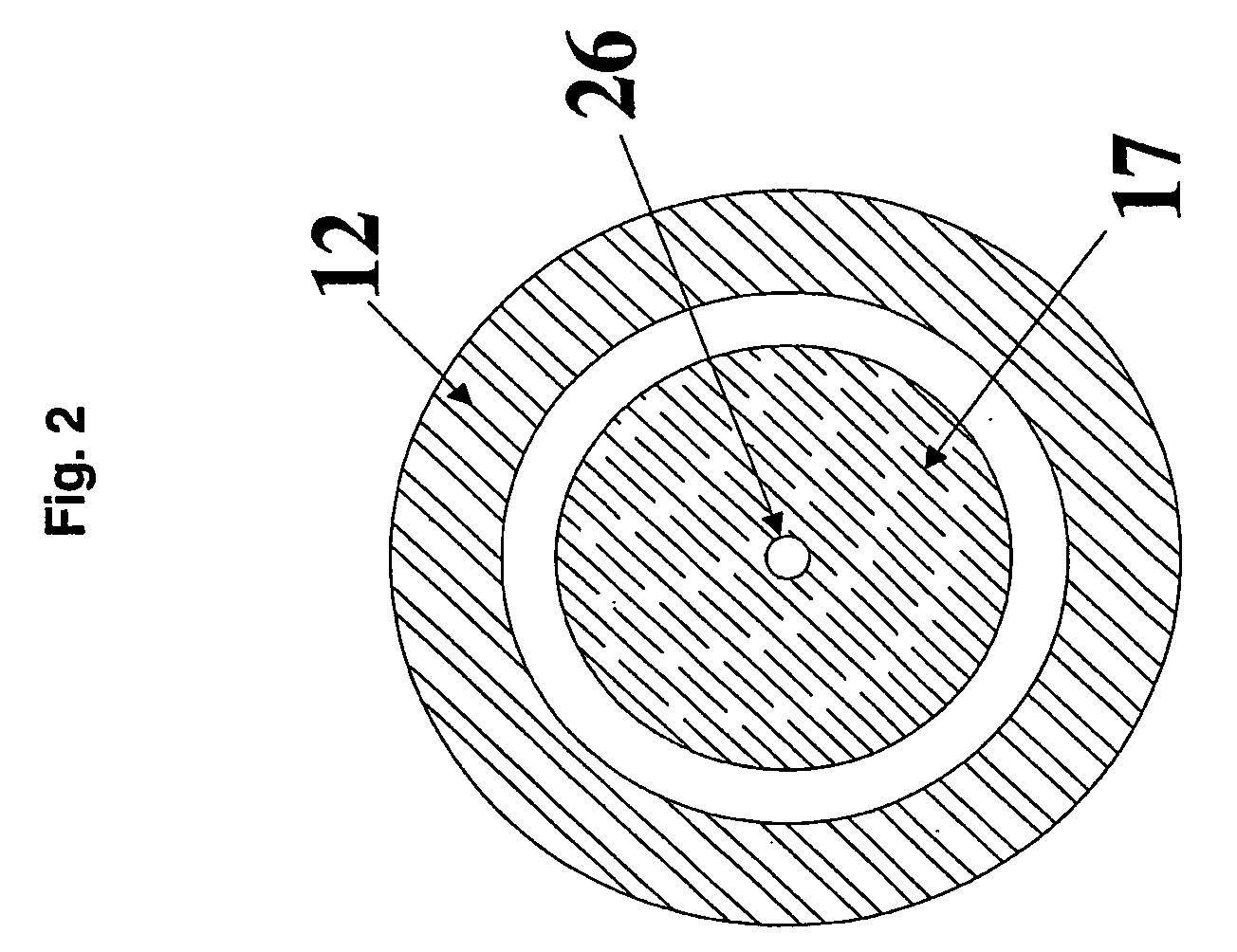Method for Burning of Gaseous and Burner
- Summary
- Abstract
- Description
- Claims
- Application Information
AI Technical Summary
Benefits of technology
Problems solved by technology
Method used
Image
Examples
example 1
[0043]The burner configuration described in this example has been applied for propane as gaseous fuel. In this example, eight primary orifices 18 with a diameter of 3 mm are arranged in a circular row around the circumference of the narrow beginning 16) of the burner head 15. The outer tube 11 diameter D1 is 100 mm and the conical converging section 12 has a minimum diameter D2 of 75 mm. The inner gaseous fuel tube 13 has an outer diameter D3 of 30 mm, while the burner head 15 has a maximum diameter D4 of 70 mm and a length L1 of 50 mm. The burner head 15 is positioned in such a way that the distance L2 from the end of the conical converging section 12 to the end of the burner head 15 is 25 mm.
example 2
[0044]The burner configuration described in this example has been applied for natural gas (82.35% methane, 13.83% ethane, 1.10% butane, 1.13% nitrogen, 1.49% carbon monoxide and 0.10% heavier hydrocarbons) as gaseous fuel. The burner configuration is as described above, but some dimensions have been changed.
[0045]In this example, eight primary orifices 18 with a diameter of 4 mm are arranged in a circular row around the circumference of the narrow beginning 16 of the burner head 15. The outer tube 11 diameter D1 is 100 mm and the conical converging section 12 has a minimum diameter D2 of 75 mm. The inner gaseous fuel tube 13 has an outer diameter D3 of 30 mm, while the burner head 15 has a maximum diameter D4 of 70 mm and a length L1 of 50 mm. The burner head 15 is positioned in such a way that the distance L2 from the end of the conical converging section 12 to the end of the burner head 15 is 32 mm.
example 3
[0046]The burner configuration described in this example has been applied for propane as gaseous fuel. The burner configuration is as described above, but the dimensions have been changed.
[0047]In this example, eight primary orifices 18 with a diameter of 4.1 mm are arranged in a circular row around the circumference of the narrow beginning 16 of the burner head 15. The outer tube 11 diameter D1 is 136 mm and the conical converging section 12 has a minimum diameter D2 of 102 mm. The inner gaseous fuel tube 13 has an outer diameter D3 of 42 mm, while the burner head 15 has a maximum diameter D4 of 96 mm and a length L1 of 68 mm. The burner head 15 is positioned in such a way that the distance L2 from the end of the conical converging section 12 to the end of the burner head 15 is 34 mm.
[0048]These dimensions from examples 1 to 3 are summarized in Table 1. Emissions of NOx and CO measured from the burners described in example 1 to 3 is shown in FIGS. 4 to 6, respectively.
TABLE 1Exampl...
PUM
 Login to View More
Login to View More Abstract
Description
Claims
Application Information
 Login to View More
Login to View More - R&D
- Intellectual Property
- Life Sciences
- Materials
- Tech Scout
- Unparalleled Data Quality
- Higher Quality Content
- 60% Fewer Hallucinations
Browse by: Latest US Patents, China's latest patents, Technical Efficacy Thesaurus, Application Domain, Technology Topic, Popular Technical Reports.
© 2025 PatSnap. All rights reserved.Legal|Privacy policy|Modern Slavery Act Transparency Statement|Sitemap|About US| Contact US: help@patsnap.com



